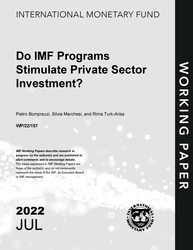
Do IMF Programs Stimulate Private Sector Investment?
Do IMF Programs Stimulate Private Sector Investment?
READ MORE...
Volume/Issue:
Volume 2022
Issue 157
Publication date: July 2022
ISBN: 9798400218842
$0.00
Add to Cart by clicking price of the language and format you'd like to purchase
Available Languages and Formats
| English |
Topics covered in this book
This title contains information about the following subjects.
Click on a subject if you would like to see other titles with the same subjects.
Exports and Imports , Investments and Securities-General , Economics- Macroeconomics , Economics / General , IMF , Firm investment , Local Projection , Financial Frictions , Difference-in-Differences , IMF arrangement , IMF working papers , firm investment response , AIPW estimate , program approval , Private investment , Financial statements , Balance of payments need , Sub-Saharan Africa
Summary
This paper provides new evidence on the role of IMF programs in stimulating private sector investments. Using detailed firm-level data on tangible fixed assets and a local projection methodology, we first estimate the dynamic response of firm investments to the approval of an IMF arrangement. We find that distinguishing between GRA and PRGT financing matters for the path of firm investment and its growth, and we also document the presence of two financial channels; the degree of firms’ external financial dependence and firms’ sectoral uncertainty. Exploiting these firm-level characteristics, we employ a difference-in-differences approach to understand the mechanisms through which the approval of an IMF arrangement propagates in the private sector. We find that the more firms rely on external finance and the more they are subject to uncertainty, the less binding these financial frictions become, and hence the more firms invest following a program approval. Finally, using ownership data, we find that private investments are stimulated more for domestic firms. The presence of a private investment transmission channel could help improve our understanding of what factors could affect the success and effectiveness of IMF programs.
Copyright © 2010 - 2025
Powered by:
AIDC



